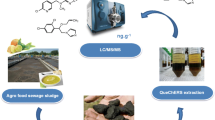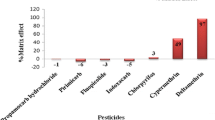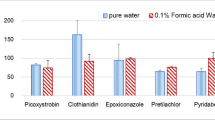Abstract
Many pesticides are used for pest control during oat production and storage, making necessary to employ multiclass methods for pesticide residue determination. In this work, an efficient QuEChERS method was established for multiresidue determination of 60 pesticides in oats by liquid chromatography with tandem mass spectrometry (LC-MS/MS). Different sorbents, such as chitosan, Forisil®, C18, PSA, Supel QuE Z-Sep+, and EMR-Lipid were evaluated for cleanup by dispersive solid-phase extraction (d-SPE). The original QuEChERS method had the best performance and the biosorbent chitosan presented similar results to the other conventional sorbents evaluated and being an efficient and low-cost biodegradable material was chosen for the cleanup step. The method presented adequate accuracy and precision using blank samples spiked between 5 and 100 μg kg−1, with recovery from 70 to 120% and RSD < 20% for all 60 pesticides and limits of quantification of 5 μg kg−1 for almost all studied pesticides, with exception of triflumizole for which was 10 μg kg−1. The method was successfully applied in real samples proven to be a good option for routine analysis. Oat samples presented residues of azoxystrobin, metalaxyl, and thiamethoxam.


Similar content being viewed by others
References
Anastassiades M, Lehotay SJ, Stajnbaher D, Schenck FJ (2003) Fast and easy multiresidue method employing acetonitrile extraction/partitioning and dispersive solid phase extraction for the determination of pesticide residues in produce. J AOAC Int 86:412–431
Anastassiades M, Scherbaum E, Taşdelen B, Šajnbaher D (2007) In: Ohkawa H, Miyagawa H, Lee PW (eds) Pesticide chemistry: crop protection, public health, environmental safety. Wiley-VCH Verlag GmbH & Co. KGaA, Weinheim, pp 439–458
Arias JLO, Rombaldi C, Caldas SS, Primel EG (2014) Alternative sorbents for the dispersive solid-phase extraction step in quick, easy, cheap, effective, rugged and safe method for extraction of pesticides from rice paddy soils with determination by liquid chromatography tandem mass spectrometry. J Chromatogr A 1360:66–75
Arias JLO, Schneider A, Batista-Andrade JA, Vieira AA, Caldas SS, Primel EG (2018) Chitosan from shrimp shells: a renewable sorbent applied to the clean-up step of the QuEChERS method in order to determine multi-residues of veterinary drugs in different types of milk. Food Chem 240:1243–1253
Bauer A, Luetjohann J, Rohn S, Kuballa J, Jantzen E (2018) Development of an LC-MS/MS method for simultaneous determination of the quaternary ammonium herbicides Paraquat, Diquat, Chlormequat, and Mepiquat in plant-derived commodities. Food Anal Methods 11:2237–2243
Brazil (2012) Ministry of Agriculture, Livestock and Food Supply - Ordinance n° 325, of December 6, 2012
Cabrera LC, Martins ML, Primel EG, Prestes OD, Adaime MB, Zanella R (2012) Dispersive solid phase extraction in the determination of residues and contaminants in food. Scientia Chromatographica 4:227–240
Cabrera LC, Caldas SS, Prestes OD, Primel EG, Zanella R (2016) Evaluation of alternative sorbents for dispersive solid-phase extraction clean-up in the QuEChERS method for the determination of pesticide residues in rice by liquid chromatography with tandem mass spectrometry. J Sep Sci 39:1945–1954
De Mori C, Fontaneli RS, Santos HP (2012) Economic and conjunctural aspects of oat culture. Documents Online 136. https://ainfo.cnptia.embrapa.br/digital/bitstream/item/91354/1/2013-documentosonline-136.pdf. Accessed 15 Jan 2019
Dors GC, Primel EG, Fagundes CAA, Mariot CHP, Badiale Furlong E (2011) Distribution of pesticide residues in rice grain and in its coproducts. J Braz Chem Soc 22:1921–1930
EU Commission Regulation No 600/2010. https://eur-lex.europa.eu/LexUriServ/LexUriServ.do?uri=OJ:L:2010:174:0018:0039:EN:PDF Accessed 15 Jan 2019
Facco JF, Martins ML, Bernardi G, Prestes OD, Adaime MB, Zanella R (2014) Optimization and validation of a multiresidue method for pesticide determination in maize using gas chromatography coupled to tandem mass spectrometry. Anal Methods 7:359–365
Francesquett JF, Rizzetti TM, Cadaval TRS Jr, Prestes OD, Adaime MB, Zanella R (2019) Simultaneous determination of the quaternary ammonium pesticides paraquat, diquat, chlormequat, and mepiquat in barley and wheat using a modified quick polar pesticides method, diluted standard addition calibration and hydrophilic interaction liquid chromatography coupled to tandem mass spectrometry. J Chromatogr A 1592:101–111
Gibney MJ et al (2009) Introduction to human nutrition, 2nd edn. Wiley-Blackwell, London
Herrmann SS, Poulsen ME (2015) Clean-up of cereal extracts for gas chromatography–tandem quadrupole mass spectrometry pesticide residues analysis using primary secondary amine and C18. J Chromatogr A 1423:47–53
Kemmerich M, Rizzetti TM, Martins ML, Prestes OD, Adaime MB, Zanella R (2015) Optimization by central composite design of a modified QuEChERS method for extraction of pesticide multiresidue in sweet pepper and analysis by ultra-high-performance liquid chromatography-tandem mass spectrometry. Food Anal Methods 8:728–739
Koesukwiwat U, Lehotay SJ, Mastovska K, Dorweiler KJ, Leepipatpiboon N (2010) Extension of the QuEChERS method for pesticide residues in cereals to flaxseeds, peanuts and doughs. J Agric Food Chem 58:5950–5958
Lanças FM (2009) Modern liquid chromatography and mass spectrometry: finally “compatible”? Scientia Chromatographica 1:35–61
Lehotay SJ, Mastovska K, Lightfield AR (2005) Use of buffering and other means to improve results of problematic pesticides in a fast and easy method for residue analysis of fruits and vegetables. J AOAC Intern 88:615–629
Lucini L, Molinari GP (2011) Residues of pirimiphos-methyl in cereals and processed fractions following post-harvest spray application. J Environ Sci Health B 46:518–524
Martins GM, Toscano LC, Tomquelski GV, Maruyama WI (2009) Microbial insecticides and chemical in the control of fall armyworm on crop corn. Revista Caatinga 22:170–174
Martins ML, Kemmerich M, Prestes OD, Maldaner L, Jardim ICSF, Zanella R (2017) Evaluation of an alternative fluorinated sorbent for dispersive solid-phase extraction clean-up of the quick, easy, cheap, effective, rugged, and safe method for pesticide residues analysis. J Chromatogr A 1514:36–43
Mastovska K, Dorweiler KJ, Lehotay SJ, Wegscheid JS, Szpylka KA (2010) Pesticide multiresidue analysis in cereal grains using modified QuEChERS method combined with automated direct sample introduction GC-TOFMS and UPLC-MS/MS techniques. J Agric Food Chem 58:5959–5972
May MM, Ferronato G, Bandeira NMG, Prestes OD, Zanella R, Adaime MB (2017) Determination of pesticide residues in soy-based beverages using a QuEChERS method (with clean-up optimized by central composite design) and ultra-high-performance liquid chromatography-tandem mass spectrometry. Food Anal Methods 10:369–378
Melo A, Cunha SC, Mansilha C, Aguiar A, Pinho O, Ferreira IMPLVO (2012) Monitoring pesticide residues in greenhouse tomato by combining acetonitrile-based extraction with dispersive liquid-liquid microextraction followed by gas-chromatography-mass spectrometry. Food Chem 135:1071–1077
Rasche C, Fournes B, Dirks U, Speer KN (2015) Multi-residue pesticide analysis (gas chromatography-tandem mass spectrometry detection)-improvement of the quick, easy, cheap, effective, rugged, and safe method for dried fruits and fat-rich cereals-benefit and limit of a standardized apple purée calibration (screening). J Chromatogr A 1403:21–31
Rekha NSN, Prasad R (2006) Pesticide residue in organic and conventional food-risk analysis. J Chem Health Saf 13:12–19
SANTE (European Commission) Guidance document on analytical quality control and method validation procedures for pesticides residues analysis in food and feed. Documento N° SANTE/11813/2017
Santilio A, Stefanelli P, Girolimetti S, Dommarco R (2011) Determination of acidic herbicides in cereals by QuEChERS extraction and LC/MS/MS. J Environ Sci Health B 46:535–543
Sterna V, Zute S, Brunava L (2016) Oat grain composition and its nutrition benefice. Agric Agric Sci Procedia 8:252–256
Walorczyk S, Drożdżyński D (2012) Improvement and extension to new analytes of a multi-residue method for the determination of pesticides in cereals and dry animal feed using gas chromatography–tandem quadrupole mass spectrometry revisited. J Chromatogr A 1251:219–231
Wang H, Ding J, Ren N (2016) Recent advances in microwave-assisted extraction of trace organic pollutants from food and environmental samples. Trends Anal Chem 75:197–208
Acknowledgments
The authors acknowledge the financial support and fellowships granted by the Brazilian agencies CNPq, CAPES, and FAPERGS.
Funding
This study was funded by the National Council of Scientific and Technological Development (CNPq), Brazil.
Author information
Authors and Affiliations
Corresponding author
Ethics declarations
Conflict of Interest
Estéfani M. C. de Matos declares that she has no conflict of interest. Fabiane M. Stringhini declares that she has no conflict of interest. Lucila C. Ribeiro declares that she has no conflict of interest. Osmar D. Prestes declares that he has no conflict of interest. José A. G. da Silva declares that he has no conflict of interest. Bruna S. de Farias declares that she has no conflict of interest. Luiz A. de A. Pinto declares that he has no conflict of interest. Renato Zanella declares that he has no conflict of interest.
Ethical Approval
This article does not contain any studies with human participants or animals performed by any of the authors.
Informed Consent
Informed consent was obtained from all individual participants included in the study.
Additional information
Publisher’s Note
Springer Nature remains neutral with regard to jurisdictional claims in published maps and institutional affiliations.
Electronic Supplementary Material
ESM 1
(DOCX 184 kb)
Rights and permissions
About this article
Cite this article
de Matos, E.M.C., Ribeiro, L.C., Prestes, O.D. et al. Multiclass Method for the Determination of Pesticide Residues in Oat Using Modified QuEChERS with Alternative Sorbent and Liquid Chromatography with Tandem Mass Spectrometry. Food Anal. Methods 12, 2835–2844 (2019). https://doi.org/10.1007/s12161-019-01641-1
Received:
Accepted:
Published:
Issue Date:
DOI: https://doi.org/10.1007/s12161-019-01641-1




